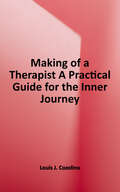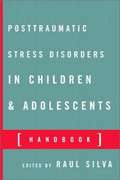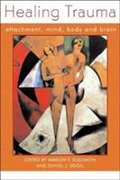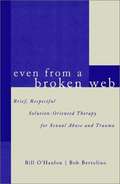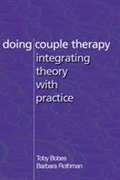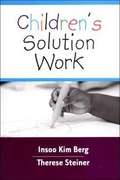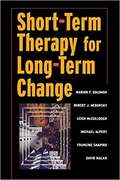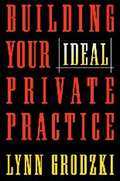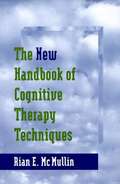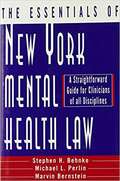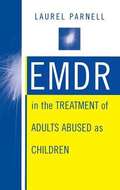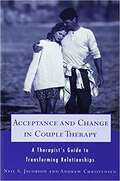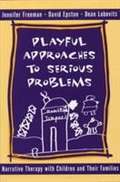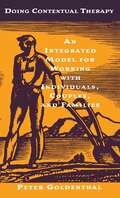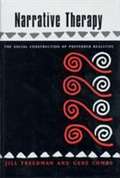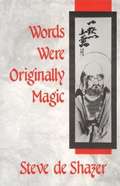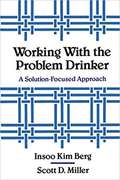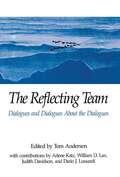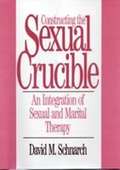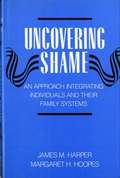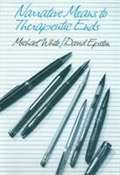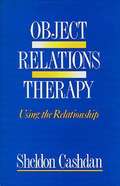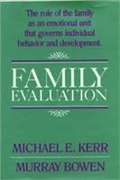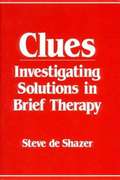- Table View
- List View
The Making of a Therapist: A Practical Guide for the Inner Journey
by Louis J. CozolinoA paperback edition of the classic guide for new therapists seeing clients for the first time. Veteran therapist and mental health writer Louis Cozolino’s classic text contains all of the things he wished someone had told him during the first weeks and months of his clinical training. Now available in paperback, the book includes guidance about working with your clients, such as how to cope with silence, handle their direct questions, and get them to talk less and say more. It also focuses on the inner experience of becoming a therapist and ways of thinking and feeling while sitting across from clients. It speaks honestly about not having all the answers, and shuttling up and down between your head and your heart, and mind and body, struggling clients sit before you. It balances the process of developing therapeutic skills while also taking an inner journey—to becoming the professional, and person, you hope to be. With a new introduction to the paperback edition, this book remains an essential clinical reference. A Test Bank is available for professors using the book as a course text.
Posttraumatic Stress Disorder in Children and Adolescents Handbook
by Raul R. SilvaThis handbook is intended to provide clinicians with a reference guide to the most salient issues of post-traumatic stress disorder (PTSD), stress, trauma, and the concurrent conditions that affect children and adolescents.
Healing Trauma: Attachment, Mind, Body, and Brain
by Daniel J. Siegel Marion F. SolomonAs we move into the third millennium, the field of mental health is in an exciting position to bring together diverse ideas from a range of disciplines that illuminate our understanding of human experience: neurobiology, developmental psychology, traumatology, and systems theory. The contributors emphasize the ways in which the social environment, including relationships of childhood, adulthood, and the treatment milieu change aspects of the structure of the brain and ultimately alter the mind.
Even From a Broken Web: Brief, Respectful Solution-Oriented Therapy for Sexual Abuse and Trauma
by Bob Bertolino Bill O'HanlonIn this book, Bill O'Hanlon, a co-developer of solution-oriented therapy, and Bob Bertolino, provide clinicians with forward-looking, respectful therapy that taps into and honors people's inherent learning abilities. Their treatment model is a major departure from most addressing sexual abuse victims: it is less traumatic, less painful, and less disruptive to people's lives.
Doing Couple Therapy Integrating Theory With Practice
by Toby Bobes Barbara RothmanHere, in one brief volume, are the answers to these questions and many others. Doing Couple Therapy will be a lifesaver for family therapy students and beginning therapists. In a straightforward manner, the authors sift through years of family therapy theory to draw out for readers a a treasury of ways to sort out the many factors, past and present, that crowd couples' relationships. These include family-of-origin issues, previous relationships, secrets, children, in-laws, unresolves lodes, job demands, financial worries--to name just a few. The authors' framework, built from the major influential theories of family and marital therapy, will enable therapists to work effectively and briefly, though not superficially, with couples. The book not only presents theory but also links theory with practice. An extraordinary contribution is the presentation of a typical case from beginning to end, through tender moments, rough spots, family-of-origin work, revelation of deeply held secrets, alcohol abuse, ultimatums, and finally, renewal of commitment to the relationship. This practical, real-life guide to couple therapy will give both students and seasoned therapists a new take on the demanding work of couple therapy.
Children's Solution Work
by Insoo Kim BergFocusing on solutions and not problems, thinking about the future and not the past, and understanding the effects of miracles―children do these things naturally. Here, leaders in the solution-focused approach to therapy provide clinicians with a guide to a kind of therapy that fits with children's natural way of being.
Short Term Therapy For Long Term Change
by Francine Shapiro Michael Alpert Marion Solomon Marion F. Solomon David Malan Robert J. Neborsky Leigh McculloughCan the effects of early childhood traumas―traumas that may have seemed small at the time but that have affected personality development―be overcome in short-term therapy? Here, leaders in the field of short-term therapy present a definitive statement on state-of-the-art intensive dynamic short-term psychotherapy. While they have approached these questions from different perspectives, the renowned practitioners in this book note points of contact and overlap among their ideas about the underlying causes of depression, maladjustment, marital discord, character pathology, and posttraumatic stress disorders. Each outlines the precise methods he or she uses with patients to create emotional growth and reintegration, illustrating these with cases and transcripts. Their methods can be proven scientifically valid, taught to others, and reliably reproduced by effectively trained psychotherapists with a wide variety of patients. Readers will find variations on the theme of short-term therapy for long-term change. Habib Davanloo was a colleague of Malan’s and has influenced Neborsky, Alpert, and McCullough. While Neborsky has devoted himself to refining and presenting clearly Davanloo’s theory and method, Alpert has developed a method of accelerated empathic treatment and McCullough has designed an anxiety-regulating therapy that is the subject of several research studies. Solomon has applied dynamic theories to treatment of intimate relationships. Shapiro, using EMDR, approaches Big-T and small-t traumas in what seems initially a quite different way but is shown ultimately to have many similarities to short-term dynamic psychotherapy. With this basis in research and clinical practice, the theories and methods presented here have the potential to revolutionize psychodynamic psychotherapy.
Building Your Ideal Private Practice: A Guide for Therapists and Other Healing Professionals
by Lynn GrodzkiProfessional business coach and psychotherapist in private practice discusses psychological and business strategies for developing a successful private practice. Includes information on dealing with managed care, as well as how to adapt to an ever-changing marketplace.
The New Handbook of Cognitive Therapy Techniques
by Rian E. McmullinFor therapists with a good grounding in the approach, Hawaii-based clinical psychologist McMullin describes, explains, and demonstrates over 100 techniques of cognitive therapy. For each he provides the theoretical basis, a thumbnail description, case examples, and resources for further information. He here adds seven new chapters to his 1986 Handbook of Cognitive Therapy Techniques that explain how to teach basic concepts, uncover harmful schemas, and resynthesize historical and cultural beliefs. Annotation c. Book News, Inc., Portland, OR (booknews.com)
The Essentials of New York Mental Health Law: A Straightforward Guide for Clinicians of All Disciplines
by Michael L. Perlin Stephen H. Behnke Marvin BernsteinDesigned to dispel the mystery and alleviate the anxiety that many clinicians associate with the legal system, this volume surveys New York law as it applies to clinical practice and answers questions most often asked by clinicians. An indispensable guide for clinicians and students.
EMDR in the Treatment of Adults Abused as Children
by Laurel ParnellThis book shows therapists how to integrate EMDR (eye movement desensitization and reprocessing) into the treatment so that adults who have been abused as children clear their trauma more rapidly, escape falling into the victim mentality, and proceed to lead full, productive lives. For therapists already familiar with EMDR, it covers the primary treatment issues and symptomatology of these clients and specific alterations of the standard EMDR protocol. For therapists experienced with treating abuse survivors, it introduces a safe and effective way to process trauma. <p><p> Emphasizing the practical, Laurel Parnell not only teaches many techniques to help the therapist when an impasse is reached, but also provides a selection of treatment choices. She demonstrates how EMDR can be used in the beginning phase of therapy for ego strengthening and the development and installation of resources. This prepares clients for trauma processing in the middle phase. Finally, in the end phase, clients integrate their experiences and often feel an awakening of their creativity and spirituality. Cases are used throughout to provide therapists with a deeper, more grounded understanding of different kinds of abuse cases and their treatment.
Acceptance And Change In Couple Therapy: A Therapist's Guide To Transforming Relationships
by Andrew Christensen Neil S. JacobsonAcceptance and Change in Couple Therapy: A Therapist's Guide to Transforming Relationships (Norton Professional Books (Paperback))
Playful Approaches to Serious Problems: Narrative Therapy with Children and their Families
by David Epston Jennifer Freeman Dean LobovitsThe "grown-up talk" of therapy is likely to turn off children - especially if it focuses on their problematic behavior. The highly effective techniques of narrative therapy include children by respecting their unique language, stories, and views of the world. This book describes a basic theory of collaborative narrative play, as well as verbal and nonverbal techniques that clear the way for stories of hope, possibility, and change. Compelling case examples, drawn from the authors' work, will appeal to parents and educators as well as therapists.
Doing Contextual Therapy: An Integrated Model For Working With Individuals, Couples, And Families
by Peter GoldenthalThis book explains this deeply ethical approach of contextual therapy in practical terms and demonstrates its practice in extensive cases.
Narrative Therapy: The Social Construction of Preferred Realities
by Jill Freedman Gene CombsOffers a fundamental understanding of the narrative approach to therapy and illustrates some of the potential applications of the technique.
Words Were Originally Magic
by Steve De ShazerIn explicating how language works in therapy, De Shazer ranges widely, citing and critiquing Lacan, Bateson, Ackerman, and Weakland, among others. But the heart of this book can be found in the detailed conversations between client and therapist that show solution-focused therapy in action.
Working With the Problem Drinker: A Solution-Focused Approach
by Scott D. Miller Insoo Kim Berg Insoo BergAt a time when the accepted standard treatment for alcoholism is long-term and expensive, solution-focused therapy, as developed at the Brief Family Therapy Center in Milwaukee, offers a brief and cost-effective alternative. Insoo Kim Berg and Scott D. Miller believe that a focus on solutions, rather than pathology, is the most constructive strategy for working with problem drinkers; their foremost concern is with what works. To this end they don't reject traditional treatment programs; rather, they view them as one part of a flexible and multidimensional approach to alcohol abuse treatment. <p><p> The authors successfully utilize solution-focused therapy in their work with problem drinkers, but it is their philosophy of working with clients―and within clients' belief systems―to encourage change that is at the heart of their model. The model, grounded in the philosophy of solution-focused brief therapy, introduces a paradigmatic change in the approach to substance abuse treatment. Rather than treating a problem drinker, Berg and Miller work with clients to treat problem drinking. The authors' refreshing blend of respect for their clients and optimism about their ability to stop abusive drinking offers hope to clients who can't fit into traditional long-term programs or who have given up on themselves. This book shows how clients can be helped to construct a future where drinking or substance abuse is no longer a problem. <p><p> Solution-focused therapy, based on respect for and collaboration with the client, concentrates on success and solutions. Therapists develop goals with the client, rather than imposing "appropriate" treatment objectives. If one solution doesn't work, the technique―not the client―is blamed and client and therapist go on to "do something different." The authors' model is much more than a list of interventions; it is a multi-faceted approach to treatment, which can adapt to anything that works, whether brief therapy, AA, or more formal inpatient programs.
The Reflecting Team: Dialogues and Dialogues About the Dialogues
by Tom AndersenWhat happens when the barriers between therapists and clients are removed, when they all participate in a dialogue about change, and when therapists and clients even trade places? As Lynn Hoffman says in her forward to this remarkable book, it "dramatically alters a family's position in relation to the professionals they have come to see." In the process, it changes the roles, rules, and expectations of therapy. Operating within the reflecting team format, professionals meet clients without preexisting hypotheses. Together they engage in a conversation that becomes a search for the not-yet-seen and the not-yet-thought-of, as well as for alternative understandings of what has been defined as problematic. As clients and therapists trade places and various members of the entire group participate in conversations, the possibilities for change open wide. This book describes the evolution of this radical strategy in Tromso, Norway, and its adaptation by various family therapists in the United States. It begins in Part I with a description of the settings in which the reflecting team developed and its history and evolution. Then basic concepts, practical considerations, and guidelines for practice are detailed. Part II contains Dialogues About the Dialogues, that is, reflections on the client-therapist-consultant-team dialogues that distinguish this innovative approach to therapy. As roles shift and various participants offer definitions of the problem and possible solutions, traditional ideas about the boundaries of a "case study" are shattered. Readers will find that this fluid, encompassing perspective stimulates their own thoughts about therapy, shaking them from outgrown assumptions. Since this approach is still evolving, the final chapter is, appropriately, a reflection on the changes that have taken place since the European edition of this book was published.
Constructing the Sexual Crucible: An Integration of Sexual and Marital Therapy
by David SchnarchBy integrating individual, sexual and marital therapies, this study attempts to provide a fresh look at the nature of intimacy and the diverse barriers to eroticism in marriage. The author refutes the common focus on sexual technique, calling instead for an emphasis on sexual potential.
Uncovering Shame: An Approach Integrating Individuals and Their Family Systems
by James Harper Margaret HoopesThis work articulates a conceptual model of shame and guilt intended to help professionals assess and identify not only shame-prone individuals but also the family systems in which it has developed.
Narrative Means to Therapeutic Ends
by Michael White David EpstonThis book provides the foundational, theoretical and clinical applications for narrative therapy.
Object Relations Therapy: Using the Relationship
by Sheldon CashdanCashdan's expertise as a teacher is amply demonstrated as he outlines the steps of object relations therapy, from engagement, through identification and confrontation within the therapy relationship--those centering around issues of dependency, sexuality, power, and ingratiation.
Family Evaluation: The Role of Family as an Emotional Unit that Governs Individual Behavior and Development
by Michael E. Kerr Murray BowenMichael Kerr (who worked with Bowen for many years) and Bowen propose that the enormously complex task of evaluating a clinical family can be orderly when it is grounded in family systems theory. Using family diagrams and case studies, the book is devoted to an elegant explication of Bowen theory, which analyzes multigenerational family relationships and conceptualizes the family as an emotional unit or as a network of interlocking relationships, not only among the family members, but also among biological, psychological, and sociological processes. Bowen's persistent inquiry and devotion to family observation, in spite of obstacles and frustrations, have resulted in a theory that has radically changed our ways of looking at all behavior.
Clues: Investigating Solutions In Brief Therapy
by Steve De ShazerOnce therapist and client are focused on investigating solutions rather than problems, therapy inevitably becomes brief―sometimes only one session. Engaging cases, often with surprising twists, illustrate this practice-based theory of brief therapy with a wide range of complaints. Both theoretically stimulating and clinically sound, de Shazer's investigations turns up clues with the potential to revolutionize the way psychotherapy is thought about and practiced.
The Art of the Psychotherapist (A Norton Professional Book)
by James BugentalUnlike the brief, specific-solution oriented therapies that many people demand today, the goal of depth therapy is life change. James Bugental has been practicing, teaching and writing about depth therapy for 40 years, and in this book, he shares his experiences as a psychotherapist.
